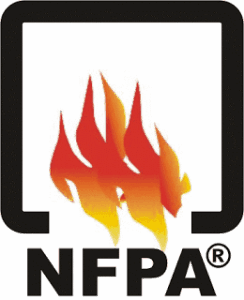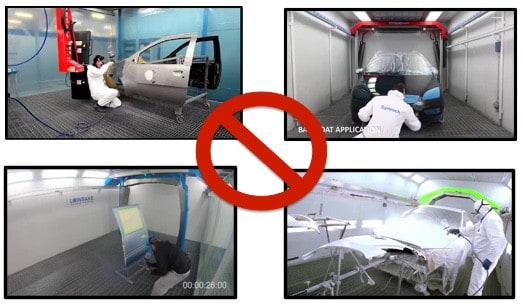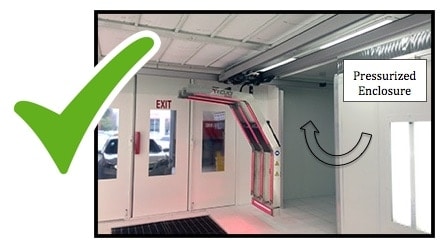 |
 |
Is your Infra-Red System Code Compliant?
Infra-Red Systems, are you putting your shop at risk? When talking about infrared systems, one of the most overlooked questions is whether or not this system will meet all the code requirements when installed in a shop. If this question is not being asked when purchasing, there could be trouble down the road. This may not apply in all situations and infrared systems used in a different way may not violate codes. However, in the chance that a system is not code compliant, then the best case scenario is a fine; worst case scenario the entire operation is lost to a fire. Neither of these are favorable scenarios and can be avoided by understanding what the codes are and how they apply in each situation.
In order to tackle this beast of compliancy, we will start with, what is the code: specifically speaking, National Fire Protection Association (NFPA) 33, the national code (ANSI Standard) for spray application using flammable or combustible materials. NFPA33 is the basis used for the development of the International Fire Code (IFC). Either NFPA33 or the IFC are what is adopted as law in the U.S.
Since the topic is specifically related to the infra-red systems that are for drying or curing, the primary sections that apply for this review are NFPA33 chapter 13 and, to some extent, 14. It will not be enough to just copy and paste the code here for anyone to read, but to actually break the code down piece-by-piece for ease of understanding.
First and foremost, taking a look at NFPA33 Chapter 13.3.1.4, it is clear that any drying or curing system that one uses in their operation must be listed. It reads,
Radiant drying apparatus that is permanently attached to the walls, ceiling, or partitions of the spray area shall be listed for exposure to flammable or combustible vapors, mists, dusts, residues, or deposits. (13.3.1.4)
This simply means that it has a rating from the proper standards Listing Agency (UL, ETL, CSA, FM, etc.) that states that the product can be used in a certain classified area. For example, inside Spray Booths or Limited Finishing workstations are classified as Class I, Division 1 & Division 2 areas as per NFPA 33 6.3.1.1& 6.3.2.1. So, any machinery that is to be used within the Spray Booth or Limited Finishing Workstation:
♦ Must be listed for Class I Division 1 & Class II Division 1 Use
♦ Any other Listing Class I Division 2 or Class II Division 1 or 2 requires the location of the Infra-Red system to be located outside of the Classified Zone.
|
What are the Electrical Classification Areas? (For additional code information please refer to NFPA33 Standard for Spray Application Using Flammable or Combustible Materials) Class I Div. 1 – Ignitable concentration of Flammable gas or vapor can exist under normal operating conditions……… Class I Div. 2 – A flammable gas or a volatile flammable liquid is handled, processed, or used ……. is confined to a closed container or a closed system form which it can escape only in case of accidental rupture or breakdown of the container…… Class II Div. 1 – Combustible dust is in the air in quantities sufficient to produce explosive or ignitable mixtures under normal operating conditions……. Class II Div. 2 – Combustible dust due to abnormal operations might present in the air in quantities sufficient to produce explosive or ignitable mixtures…….. |
Now that the classification of areas in and around spray application areas has been defined, NFPA 33 speaks specifically to different apparatus used for drying and curing, specifically permanent fixtures. A permanent fixture is any apparatus that cannot be removed from the spray booth during normal operation, which means anytime the spray booth is used for application purposes. NFPA 33 13.3.1.5 reads,
Radiant drying, curing, or fusion apparatus that is permanently attached to the structure of a spray booth and is movable but is suitable only for use in an Ordinary Hazard (general purpose) location, that is, is not suitable for a hazardous (classified) location as defined in NFPA 70 shall be permitted to be used provided the following conditions apply:
(1) The apparatus can be moved into a pressurized enclosure that meets the requirements for Type X pressurizing, as specified in NFPA 496.
(2) Interlocks are provided both to prevent the use of the spray application equipment unless the drying, curing, or fusion apparatus has been moved into the pressurized enclosure and the enclosure has been purged and pressurized in accordance with NFPA 496 and to prevent the actuation of the drying, curing, or fusion apparatus when it is located in the enclosure.
So, the first part of the code states that a permanent fixture can be used in a spray booth when it meets specific requirements if it is not listed for use during normal operation. Those requirement are then listed as (1) and (2). So, as per (1), the drying or curing apparatus may be present within the spray booth provided that it has a separate enclosure that is pressurized while the spray application process is occurring. Further, there must be a system in place that if the drying or curing apparatus is outside of the pressurized enclosure, interlocks prevent normal operation, which again is application with spray guns, according to (2).
Another thing to consider is for those that use limited finishing workstations for their application processes. Chapter 14.3.7 states that these limited finished workstations must meet the same standards as spray booths. Further, many think that 14.3.8 can be used as a loop-hole in that “portable” refers to any system that moves, however, it refers more to a system that is handheld and can be removed from the workstation.
If your permanently affixed drying or curing unit meets these standards then you are fine, and you and your operation is not at risk of fine or fires. However, it has become abundantly clear that this is not the typical case for most operation or drying or curing apparatus.
Finally, if you are spraying in the general shop area (Spray Area) and not in a Spray Booth or a Limited Finishing Workstation then you are in an entire new category. The Spray Area is still defined as Class I Div. 1 and Class II Div. 1 and would require any equipment not listed as such to be placed outside the zone. To complicate it further the code states in 6.5.1:
Electrical wiring and utilizations equipment (Infra-red or other electrical devices) located within 20 feet horizontally and 10 feet vertically of an unenclosed spray area and not separated from the spray area by partitions extending to the boundaries of the area then the equipment must be listed Class I Div. 2 or Class II Div. 2, whichever is applicable.
So if your equipment is not Listed to either of these requirements then the equipment must be located over 20 feet away.
Here are some important questions to ask about an Infra-Red drying or curing system:
Is it listed?
- Class I Div. 1, Class I Div. 2, Class II Div. 1 or Class II Div. 2
If “Yes”, which listing is it?
- Class I Div. 1 Listed (Vapors) – Tested for vapors – Must be located outside of the spray area during spray operations. Outside of the Spray Booth (separate enclosure), Limited Finishing Workstation, or Prep Station/Shop area (outside the spray radius (subject to Jurisdiction interpretation) around part being sprayed).
- Class I Div. 2 Listed (Vapors) – Tested for vapors – Must be located outside of the spray area during spray operations. Outside of the Spray Booth (separate enclosure), Limited Finishing Workstation, or Prep Station/Shop area (outside the spray radius (subject to Jurisdiction interpretation) around part being sprayed).
- Class II Div. 1 Listed (Residues) – Tested for residues – Must be located outside of the spray area during spray operations. Outside of the Spray Booth (separate enclosure), Limited Finishing Workstation, or Prep Station or shop area (outside the spray radius (subject to Jurisdiction interpretation) around part being sprayed).
- Class II Div. 2 Listed (Residues) – Tested for residues – Must be located outside of the spray area during spray operations. Outside of the Spray Booth (separate enclosure), Limited Finishing Workstation, or Prep Station or shop area (outside the spray radius (subject to Jurisdiction interpretation) around part being sprayed).
- Combination of Listings – Class I Div. 1 Listed (Vapors) & Class II Div. 1 Listed (Residues) – Tested for both Vapors & Residues – Allowed in any Spray Booth, Limited Finishing Workstation, or Prep Station or shop area spraying at any time.
- Not Listed – Not allowed to be located in any Spraying environment or Residue collection areas at all. Special requirements apply (see above (1) and (2)in red)
Here are some examples of what would be considered violations of the requirements:
1. Spraying with the improperly Listed Infra-Red equipment (see above Listing Requirements) in the Spray Area (Spray Booth or Limited Finishing Workstation). This should be located outside the area during spraying. The only way this device could be in this area is that it has been Listed for Class I Div. 1 & Class II Div. 1 Requirements.

2. Spraying in the Open area with no partitions in place and an improperly Listed Infra-Red Equipment. The only way this equipment could be in this area is if it was Listed to Class I Div. 1 & Class II Div. 1 Requirements. Since it is being sprayed in an open area with no partitions then the equipment may have to be located 20 feet away if it does not carry any type of Listing (See Listing requirements above)

3. This design that meets the requirements – This system, although not Listed to Class I Div. 1 & Class II Div. 1 requirements, has a pressurized enclosure where the Infra-Red unit can be parked during spray operations.

If you are thinking about purchasing an Infra-red system or already have one in your operation, make sure they meet the standards? So, ask the questions:
♦ Is it listed?
♦ If “Yes,” which listing is it?
Then based on the Listing, assure that the equipment is used properly per the requirements. Protect your shop from being fined or shut down or a fire situation!
*This article is written by Barry Thomas and based on his professional opinion and may not reflect the opinion of the NFPA committee’s views. If you would like to get a “Formal Interpretation” from the committee ask at www.nfpa.org



As long as the installation has the pressurized closet and controls in use during spray application, then “Yes” it is compliant!
The picture above shows a GFS installation…..